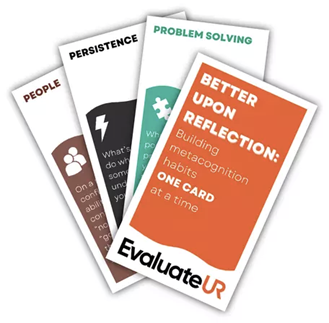by John Schumacher & Roman Taraban at Texas Tech University
In prepping for upcoming classes, we are typically interested in how to best structure the class to promote the most effective learning. Applying best-practices recommendations in the literature, we try to implement active learning strategies that go beyond simple lecturing. One such strategy that has been found to be effective from research is the use of testing. The inference to draw from the research literature is quite simple: test students frequently, informally, and creatively, over and above standard course tests, like a mid-term and final. Testing is a useful assessment tool, but research has shown that it is also a learning tool that has been found to promote learning above and beyond simply rereading material (Roediger & Karpicke, 2006a). This is called the testing effect. In controlled studies, researchers have shown testing effects with a variety of materials, including expository texts and multimedia presentations (e.g., Carrier & Pashler, 1992; Huff, Davis, & Meade, 2013; Johnson & Mayer, 2009; Roediger & Karpicke, 2006b). Testing has been found to increase learning when implemented in a classroom setting (McDaniel, Anderson, Derbish, & Morrisette, 2007) and is a useful learning tool for people of all ages (Meyer & Logan, 2013). The theoretical explanation for the benefits of testing is that testing strengthens retrieval paths to the stored information in memory more so than simply rereading the material. Therefore, later on a person can more effectively recover the information from memory.
Although implementing testing and other active learning strategies in the classroom is useful in guiding and scaffolding student learning, it is important that we develop an understanding of when and for whom these strategies are most helpful. Specifically, regarding testing, research from our lab and in others is starting to show that testing may not always be as beneficial as past research suggests. Characteristics of the students themselves may nullify or even reverse the benefits of testing. Thus, the first question we address is whether frequent classroom testing will benefit all students. Yet a more pertinent question, which is our second question, is whether frequent testing develops metacognitive practices in students. We will discuss these in turn.
In a formal study of the testing effect, or in an informal test in any classroom, one needs two conditions, a control condition in which participants study the material on their own for a fixed amount of time, and an experimental condition in which participants study and are tested over the material, for instance, in a Study-Test-Study-Test format. Both groups spend an equal amount of time either simply studying or studying and testing. All participants take a final recall test over the material. Through a series of testing-effect studies incorporating expository texts as the learning material, we have produced a consistent grade-point average (GPA) by testing-effect interaction. This means that the benefits of testing (i.e., better later retrieval of information) depend on students’ GPAs! A closer look at this interaction showed us that students with low GPAs benefited most from the implementation of testing whereas mid to high GPA students benefited just as much by simply studying the material.
While at this preliminary stage it is difficult to ascertain why exactly low GPA students benefit from testing in our experiments while others do not, a few observations can be put forth. First, at the end of the experiments, we asked participants to report any strategies they used on their own to help them learn the materials. Metacognitive reading strategies that the participants reported included focusing on specific aspects of the material, segmenting the material into chunks, elaborating on the material, and testing themselves. Second, looking further into the students’ self-reports of metacognitive strategy use, we found that participants in the medium to high GPA range used these strategies often, while low GPA students used them less often. Simply, the self-regulated use of metacognitive strategies was associated with higher GPAs and better recall of the information in the texts that the participants studied. Lower GPA students benefited when the instructor deliberately imposed self-testing.
These results are interesting because they indicate that the classroom implementation of testing may only be beneficial to low achieving students because they either do not have metacognitive strategies at their disposal or are not applying these strategies. High-achieving students may have metacognitive strategies at their disposal and may not need that extra guidance set in place by the instructor.
Another explanation for the GPA and testing-effect interaction may simply be motivation. Researchers have found that GPA correlates with motivation (Mitchell, 1992). It is possible that implementing a learning strategy may be beneficial to low GPA students because it forces them to work with the material. Motivation may also explain why GPA correlated with metacognitive strategy use. Specifically if lower GPA students are less motivated to work with the material it stands to reason that they would be less likely to employ learning strategies that take time and effort.
This leads to our second question: Does frequent testing develop metacognitive skills in students, particularly self-regulated self-testing? This is a puzzle that we cannot answer from the current studies. Higher-GPA students appear to understand the benefits of applying metacognitive strategies and do not appear to need additional coaxing from the experimenter/teacher to apply them. Will imposing self-testing, or any other strategy on lower-GPA students lead them to eventually adopt the use of these strategies on their own? This is an important question and one that deserves future attention.
While testing may be useful for bolstering learning, we suggest that it should not be blindly utilized in the classroom as a learning tool. A consideration of what is being taught and to whom will dictate the effectiveness of testing as a learning tool. As we have suggested, more research also needs to be done to figure out how to bring metacognitive strategies into students’ study behaviors, particularly low-GPA students.
References
Carrier, M., & Pashler, H. (1992). The influence of retrieval on retention. Memory & Cognition, 20(6), 633-642.
Huff, M. J., Davis, S. D., & Meade, M. L. (2013). The effects of initial testing on false recall and false recognition in the social contagion of memory paradigm. Memory & Cognition, 41(6), 820-831.
Johnson, C. I., & Mayer, R. E. (2009). A testing effect with multimedia learning. Journal of Educational Psychology, 101(3), 621-629.
McDaniel, M. A., Anderson, J. L., Derbish, M. H., & Morrisette, N. (2007). Testing the testing effect in the classroom. European Journal of Cognitive Psychology, 19(4-5), 494-513.
Meyer, A. D., & Logan, J. M. (2013). Taking the testing effect beyond the college freshman: Benefits for lifelong learning. Psychology and Aging, 28(1), 142-147.
Mitchell Jr, J. V. (1992). Interrelationships and predictive efficacy for indices of intrinsic, extrinsic, and self-assessed motivation for learning. Journal of Research and Development in Education, 25(3), 149-155.
Roediger, H., & Karpicke, J. D. (2006a). The power of testing memory: Basic research and implications for educational practice. Perspectives on Psychological Science, 1(3), 181- 210.
Roediger, H., & Karpicke, J. D. (2006b). Test-enhanced learning: Taking memory tests improves long-term retention. Psychological Science, 17(3), 249-255.



